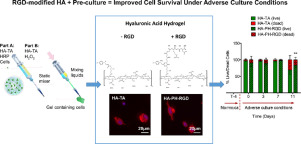当前位置:
X-MOL 学术
›
Acta Biomater.
›
论文详情
Our official English website, www.x-mol.net, welcomes your
feedback! (Note: you will need to create a separate account there.)
Pre-culture of mesenchymal stem cells within RGD-modified hyaluronic acid hydrogel improves their resilience to ischaemic conditions.
Acta Biomaterialia ( IF 9.4 ) Pub Date : 2020-03-04 , DOI: 10.1016/j.actbio.2020.02.043 Laura B Gallagher 1 , Eimear B Dolan 2 , Janice O'Sullivan 3 , Ruth Levey 4 , Brenton L Cavanagh 5 , Lenka Kovarova 6 , Martin Pravda 7 , Vladimir Velebny 7 , Tom Farrell 8 , Fergal J O'Brien 1 , Garry P Duffy 9
Acta Biomaterialia ( IF 9.4 ) Pub Date : 2020-03-04 , DOI: 10.1016/j.actbio.2020.02.043 Laura B Gallagher 1 , Eimear B Dolan 2 , Janice O'Sullivan 3 , Ruth Levey 4 , Brenton L Cavanagh 5 , Lenka Kovarova 6 , Martin Pravda 7 , Vladimir Velebny 7 , Tom Farrell 8 , Fergal J O'Brien 1 , Garry P Duffy 9
Affiliation

|
The incorporation of the RGD peptide (arginine-glycine-aspartate) into biomaterials has been proposed to promote cell adhesion to the matrix, which can influence and control cell behaviour and function. While many studies have utilised RGD modified biomaterials for cell delivery, few have examined its effect under the condition of reduced oxygen and nutrients, as found at ischaemic injury sites. Here, we systematically examine the effect of RGD on hMSCs in hyaluronic acid (HA) hydrogel under standard and ischaemic culture conditions, to elucidate under what conditions RGD has beneficial effects over unmodified HA and its effectiveness in improving cell viability. Results demonstrate that under standard culture conditions, RGD significantly increased hMSC spreading and the release of vascular endothelial factor-1 (VEGF) and monocyte chemoattractant factor-1 (MCP-1), compared to unmodified HA hydrogel. As adhesion is known to influence cell survival, we hypothesised that cells in RGD hydrogels would exhibit increased cell viability under ischaemic culture conditions. However, results demonstrate that cell viability and protein release was comparable in both RGD modified and unmodified HA hydrogels. Confocal imaging revealed cellular morphology indicative of weak cell adhesion. Subsequent investigations found that RGD was could exert positive effects on encapsulated cells under ischaemic conditions but only if hMSCs were pre-cultured under standard conditions to allow strong adhesion to RGD before exposure. Together, these results provide novel insight into the value of RGD introduction and suggest that the adhesion of hMSCs to RGD prior to delivery could improve survival and function at ischaemic injury sites. STATEMENT OF SIGNIFICANCE: The development of a biomaterial scaffold capable of maintaining cell viability while promoting cell function is a major research goal in the field of cardiac tissue engineering. This study confirms the suitability of a modified HA hydrogel whereby stem cells in the modified hydrogel showed significantly greater cell spreading and protein secretion compared to cells in the unmodified HA hydrogel. A pre-culture period allowing strong adhesion of the cells to the modified hydrogel was shown to improve cell survival under conditions that mimic the myocardium post-MI. This finding may have a significant impact on the use and timelines of modifications to improve stem cell survival in harsh environments like the injured heart.
中文翻译:

RGD修饰的透明质酸水凝胶中的间充质干细胞的预培养可提高其对缺血性疾病的适应力。
已经提出将RGD肽(精氨酸-甘氨酸-天冬氨酸)掺入生物材料中以促进细胞对基质的粘附,这可以影响和控制细胞的行为和功能。尽管许多研究已将RGD改性的生物材料用于细胞递送,但很少有研究在缺血性损伤部位发现的减少氧气和养分的条件下发挥其作用。在这里,我们系统地检查了RGD对标准和缺血培养条件下透明质酸(HA)水凝胶中hMSCs的影响,以阐明RGD在什么条件下具有优于未修饰HA的有益作用及其在改善细胞活力方面的有效性。结果表明,在标准培养条件下,与未修饰的HA水凝胶相比,RGD显着增加了hMSC的扩散以及血管内皮因子1(VEGF)和单核细胞趋化因子1(MCP-1)的释放。由于已知粘附会影响细胞存活,因此我们假设RGD水凝胶中的细胞在缺血培养条件下会表现出更高的细胞活力。但是,结果表明,在RGD修饰的和未修饰的HA水凝胶中,细胞活力和蛋白质释放均相当。共聚焦成像揭示了细胞形态,表明细胞粘附较弱。随后的研究发现,RGD可以在缺血条件下对包囊细胞产生积极影响,但前提是hMSC在标准条件下进行预培养以使其在暴露前能牢固粘附于RGD。一起,这些结果为RGD引入的价值提供了新颖的见解,并表明在分娩前hMSC与RGD的粘附可以改善缺血性损伤部位的存活率和功能。意义声明:能够维持细胞活力并促进细胞功能的生物材料支架的开发是心脏组织工程领域的主要研究目标。该研究证实了修饰的HA水凝胶的适用性,其中与未修饰的HA水凝胶中的细胞相比,修饰的水凝胶中的干细胞显示出显着更大的细胞扩散和蛋白质分泌。在允许模仿MI后心肌的条件下,预培养期可以使细胞牢固地粘附于修饰的水凝胶,从而提高细胞存活率。
更新日期:2020-03-04
中文翻译:

RGD修饰的透明质酸水凝胶中的间充质干细胞的预培养可提高其对缺血性疾病的适应力。
已经提出将RGD肽(精氨酸-甘氨酸-天冬氨酸)掺入生物材料中以促进细胞对基质的粘附,这可以影响和控制细胞的行为和功能。尽管许多研究已将RGD改性的生物材料用于细胞递送,但很少有研究在缺血性损伤部位发现的减少氧气和养分的条件下发挥其作用。在这里,我们系统地检查了RGD对标准和缺血培养条件下透明质酸(HA)水凝胶中hMSCs的影响,以阐明RGD在什么条件下具有优于未修饰HA的有益作用及其在改善细胞活力方面的有效性。结果表明,在标准培养条件下,与未修饰的HA水凝胶相比,RGD显着增加了hMSC的扩散以及血管内皮因子1(VEGF)和单核细胞趋化因子1(MCP-1)的释放。由于已知粘附会影响细胞存活,因此我们假设RGD水凝胶中的细胞在缺血培养条件下会表现出更高的细胞活力。但是,结果表明,在RGD修饰的和未修饰的HA水凝胶中,细胞活力和蛋白质释放均相当。共聚焦成像揭示了细胞形态,表明细胞粘附较弱。随后的研究发现,RGD可以在缺血条件下对包囊细胞产生积极影响,但前提是hMSC在标准条件下进行预培养以使其在暴露前能牢固粘附于RGD。一起,这些结果为RGD引入的价值提供了新颖的见解,并表明在分娩前hMSC与RGD的粘附可以改善缺血性损伤部位的存活率和功能。意义声明:能够维持细胞活力并促进细胞功能的生物材料支架的开发是心脏组织工程领域的主要研究目标。该研究证实了修饰的HA水凝胶的适用性,其中与未修饰的HA水凝胶中的细胞相比,修饰的水凝胶中的干细胞显示出显着更大的细胞扩散和蛋白质分泌。在允许模仿MI后心肌的条件下,预培养期可以使细胞牢固地粘附于修饰的水凝胶,从而提高细胞存活率。











































 京公网安备 11010802027423号
京公网安备 11010802027423号